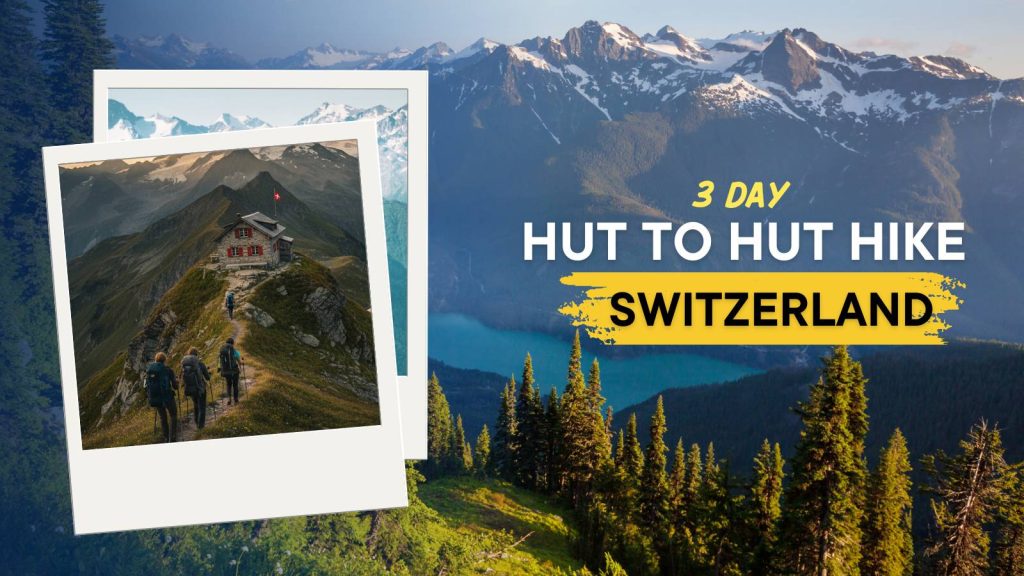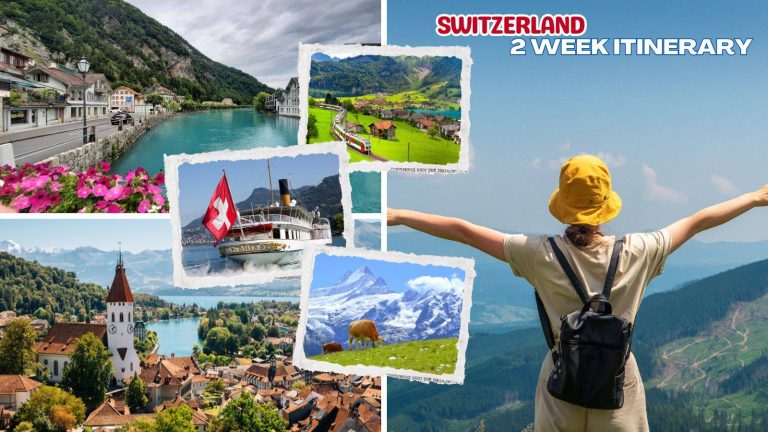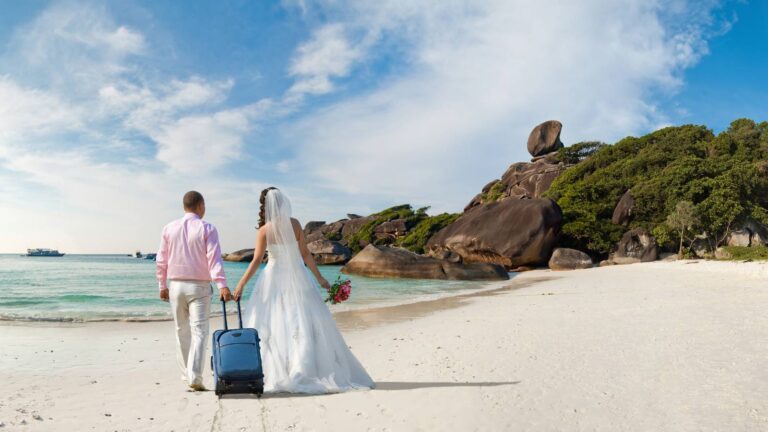Switzerland is renowned for its breathtaking alpine landscapes, pristine lakes, and majestic mountain peaks. For hiking enthusiasts, there’s no better way to explore this natural beauty than through a 3 Day Hut to Hut Hike Switzerland.
Swiss Travel Pass Flex: Price, Benefits, How to Use & Activation+ Pass Comparison
Day hikes that require returning to a base town each night, hut-to-hut trekking allows hikers to immerse themselves fully in the alpine environment. This style of hiking offers not only physical challenge and adventure but also a unique opportunity to stay in traditional mountain huts, enjoy local Swiss cuisine, and connect with fellow travelers from around the world.
Here are, the best routes, huts, and practical tips to ensure your 3-day adventure is both safe and unforgettable.
Why Switzerland is Perfect for Hut-to-Hut Hiking
Switzerland’s extensive network of alpine trails and mountain huts makes it one of the best countries in the world for multi-day hikes. The trails are well-marked, maintained, and offer breathtaking views at every turn. A 3 Day Hut to Hut Hike Switzerland gives you the chance to experience the Alps in a way few tourists ever do.
Switzerland Trip Itinerary for 7 Days: Where to Go, What to See & How to Save Money
Walking up to sunrise over snow-capped peaks, walk through serene alpine meadows, cross crystal-clear streams, and even spot wildlife such as marmots, ibex, and golden eagles. Staying in mountain huts enhances the experience, providing warmth, hearty meals, and a sense of community among hikers.
It’s not just a hike; it’s an opportunity to connect with nature, challenge yourself physically, and enjoy moments of solitude that are rare in today’s busy world.
Top 3 Day Hut-to-Hut Hiking Routes in Switzerland
Route 1: The Classic Alpine Trail (Zermatt to Saas Fee)
This route is ideal for hikers looking for iconic scenery and challenging terrain. The trail showcases the legendary Matterhorn and offers a classic alpine experience.
- Day 1: Begin in Zermatt, a charming car-free village surrounded by towering peaks. The trail ascends through alpine meadows dotted with wildflowers, past cascading waterfalls, and across rocky ridges, culminating at the Hörnli Hut. Here, hikers are rewarded with panoramic views of glaciers and the iconic Matterhorn. Evening at the hut includes traditional Swiss dishes like rösti or fondue.
- Day 2: The journey continues via the Theodul Pass, one of the highest accessible points on this route. You’ll cross glaciers and rocky terrain, experiencing the thrill of high-altitude hiking. The Schönbiel Hut provides a comfortable overnight stay with breathtaking glacier views from its terrace.
- Day 3: The final descent toward Saas Fee offers a gentler hike through valleys and alpine forests. Along the way, hikers can enjoy reflections of mountains in serene lakes and observe local wildlife. The trail ends in Saas Fee, a picturesque village perfect for celebrating the end of your adventure.
Difficulty Level: Challenging – recommended for hikers with previous alpine trekking experience. Proper footwear and trekking poles are essential.
Route 2: Glacier & Mountain Peaks Trek (Engelberg to Meiringen)
For those fascinated by glaciers, dramatic ridges, and high-altitude landscapes, this trail is a perfect choice.
- Day 1: Start in Engelberg and make your way to Joch Pass. The trail offers sweeping views of alpine meadows, dotted with wildflowers in summer and golden hues in autumn. The Trübsee Hut serves as your first overnight stop, offering warm meals and comfortable beds, ideal for resting before the next day’s challenge.
- Day 2: The trail crosses rocky ridges with panoramic views of glaciers and high mountain peaks. The Steinberg Hut provides shelter and a chance to experience the quiet charm of a remote mountain refuge. Hikers can enjoy the peacefulness of the Alps, far from the bustling tourist spots.
- Day 3: The final day descends toward Meiringen, passing through lush forests, cascading waterfalls, and charming alpine villages. The path is rich in biodiversity and offers opportunities for photography and wildlife spotting.
Difficulty Level: Moderate to challenging – suitable for hikers comfortable with elevation gain and occasional rocky paths. Glacier crossings require caution.
Route 3: Hidden Gem Trails (Appenzell Region)
For hikers seeking solitude and less crowded trails, the Appenzell region provides stunning landscapes and authentic Swiss alpine experiences.
- Day 1: Begin in Wasserauen and hike toward Seealpsee. The trail winds through green valleys, past streams and alpine meadows. The Seealpsee Hut overlooks the lake, offering a tranquil overnight stay. Evening meals often include local specialties like Appenzeller cheese dishes.
- Day 2: The trek continues along the Alpstein Ridge, featuring dramatic cliffside paths, rugged rock formations, and untouched alpine flora. Overnight at the Meglisalp Hut provides a rustic yet comfortable experience, allowing hikers to rest while enjoying panoramic mountain views.
- Day 3: Descend through quiet valleys, past traditional alpine farms, and return to Wasserauen. This final leg offers insight into rural Swiss life and a peaceful conclusion to your 3-day adventure.
Difficulty Level: Moderate – ideal for hikers looking for scenic beauty without extreme climbs or glacier crossings.
What to Expect on a 3-Day Hut-to-Hut Hike
A 3 Day Hut to Hut Hike Switzerland typically involves trekking 10 to 20 kilometers per day, with elevation gains ranging from 500 to 1,200 meters depending on the route. Hikers can expect a mix of terrains, including rocky paths, forested trails, alpine meadows, and sometimes snow patches even in summer.
The daily challenge is balanced by the comfort of mountain huts, where hikers can rest, enjoy hearty meals, and socialize with fellow adventurers. Wildlife encounters, such as spotting marmots, ibex, or alpine birds, are common. Additionally, the experience offers an opportunity to disconnect from urban life and embrace the serenity and grandeur of the Swiss Alps fully.
Best Mountain Huts Along the Trails
Mountain huts are central to the hut-to-hut hiking experience. They provide not only shelter but also a glimpse into Swiss alpine culture:
- Hörnli Hut (Zermatt Route): Located near the Matterhorn, this hut offers dormitory-style sleeping, traditional Swiss meals, and unmatched glacier views.
- Schönbiel Hut: Famous for its terrace overlooking glaciers and surrounding peaks. Hikers can enjoy breakfast with panoramic views.
- Trübsee Hut (Engelberg): Convenient for glacier trails, this hut provides meals and a warm place to relax after a long day.
- Meglisalp Hut (Appenzell): A rustic hut with an intimate atmosphere, perfect for watching alpine sunsets.
Tips: Always book huts in advance, especially in summer. Some huts provide meals, while others are self-catering. Carry cash, as not all huts accept cards.
Essential Gear & Packing Tips for Hut-to-Hut Hikes
Packing wisely ensures safety and comfort on a 3 Day Hut to Hut Hike Switzerland:
- Clothing: Layered clothing to adapt to changing temperatures, waterproof jackets, thermal wear for colder nights, and a hat for sun protection.
- Footwear: Waterproof, well-broken-in hiking boots with ankle support are crucial for rocky and sometimes slippery terrain.
- Accessories: Trekking poles for stability, a high-quality backpack, sunglasses, and sunscreen.
- Navigation & Safety: Trail maps, GPS apps, first aid kit, whistle, and headlamp.
- Food & Hydration: Water bottles, energy bars, and snacks. While huts provide meals, carrying some food for emergencies is essential.
- Miscellaneous: Camera, personal hygiene items, and lightweight sleeping bag liner if required by huts.
Packing light yet effectively ensures a comfortable and enjoyable hiking experience.
Seasonal Considerations: When to Hike
The best months for a 3 Day Hut to Hut Hike Switzerland are June to September. Summer trails are mostly free of snow, and mountain huts are fully operational. Early summer offers blooming wildflowers, while mid-summer ensures longer daylight hours and warmer temperatures.
Late summer to early autumn brings stunning fall colors, fewer crowds, and excellent photo opportunities. Winter and early spring are generally not suitable due to snow, avalanche risk, and hut closures. Always check weather forecasts before starting your trek, as alpine weather can change rapidly.
Trail Maps, Navigation & Planning Tips
Good planning is essential for a safe and enjoyable hike:
- Use detailed trail maps, GPS apps like SwissTopo or Komoot, and offline maps for areas with poor connectivity.
- Plan daily distances, rest points, and hut accommodations in advance.
- Utilize Switzerland’s efficient public transport system to access trailheads or return from the end of your trek.
- Allow buffer time for rest, meals, photography, and unexpected delays.
- Familiarize yourself with trail difficulty, potential hazards, and emergency contacts.
A seasoned hiker or an adventurous beginner, this experience promises unforgettable memories, breathtaking views, and a deep connection with the Swiss Alps. For anyone seeking an immersive and life-enriching alpine adventure, a 3 Day Hut to Hut Hike Switzerland is an absolute must-do.
FAQs
1. What is a 3 Day Hut to Hut Hike Switzerland?
A 3 Day Hut to Hut Hike Switzerland is a multi-day trekking route across the Swiss Alps where hikers stay overnight in mountain huts. It combines hiking adventure with comfort and local alpine cuisine.
2. How difficult is a 3 Day Hut to Hut Hike Switzerland?
Difficulty varies by route. Some are moderate and suitable for beginners with good fitness, while others involve steep ascents, rocky paths, and glacier crossings, requiring experience and proper gear.
3. When is the best time to do a 3-day hut-to-hut hike in Switzerland?
The ideal season is June to September, when trails are mostly snow-free, huts are open, and weather is generally stable. Early summer offers blooming wildflowers, while late summer brings vibrant alpine colors.
4. How do I book mountain huts for the hike?
Most huts are operated by the Swiss Alpine Club (SAC) or private owners. Book online in advance, especially during summer. Some huts accept phone reservations, but early planning is recommended.
5. How much does staying in mountain huts cost?
Prices typically range from CHF 35-70 per night for dormitory beds. Meals may be included or available at an extra cost. Some huts also provide breakfast and packed lunch options.
6. What gear is essential for a 3-day hut-to-hut hike?
Essential gear includes layered clothing, waterproof hiking boots, trekking poles, backpack, headlamp, GPS or maps, first aid kit, water bottles, snacks, and optional camera or binoculars.
7. Can beginners attempt these hikes?
Yes, beginners can attempt moderate routes. It’s recommended to start with shorter distances, allow extra time, and possibly hire a guide for challenging trails or glacier crossings.
8. Are dogs allowed on hut-to-hut trails?
Most trails allow dogs, but rules vary by hut. Dogs should be leashed, and owners must ensure they do not disturb wildlife or other hikers. Always check with the hut in advance.
9. How far do hikers usually travel each day?
Daily distances range from 10 to 20 kilometers, depending on the route. Elevation gain per day can vary from 500 to 1,200 meters. Hikers should pace themselves and account for rest breaks and sightseeing.
10. What makes a 3 Day Hut to Hut Hike Switzerland special?
This experience combines physical challenge, stunning alpine scenery, cozy mountain huts, wildlife encounters, and cultural immersion. It allows hikers to fully disconnect from urban life and enjoy Switzerland’s natural beauty.




